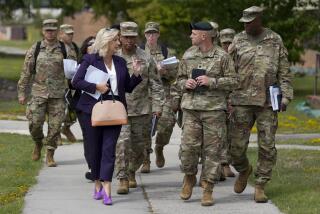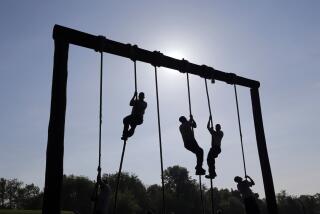Easier Army Recruitment Rules Studied
WASHINGTON — Army Secretary Louis Caldera on Tuesday proposed making it easier for young people without high school diplomas to join the Army, a move that could help a large pool of young Latinos but also could stir charges that the service is lowering its standards.
With the military facing growing recruiting difficulties, Caldera said that the Army may be better off accepting more young people who do not have traditional diplomas but have good aptitude test scores, work records or other evidence of their potential.
Army rules require that 90% of recruits hold diplomas. The remaining 10% may be accepted with high school equivalency certificates.
Caldera said that more flexible standards could enable the Army to take advantage of the untapped potential of many young people, while helping ease its longer-term--though probably not its immediate--recruiting problem.
To be put into effect, such an idea would involve study and consultations with a wide range of Army and Defense Department officials, a process that probably would take many months, one official said.
The future of the proposal is difficult to predict. One military officer acknowledged that it already has created a brouhaha within the Army bureaucracy and is likely to encounter more resistance.
The Army fell 2,300 soldiers short of its recruiting goals for the quarter that ended on Dec. 31 and now fears that it may not reach its annual goal of 74,500 recruits.
“The Army is an institution that should not write off young people,” Caldera said in an interview Tuesday. “The military traditionally has been one of those places where you can turn your life around.”
While such a change obviously would apply to young people from all backgrounds, the military has been looking hard for ways to draw in more young Latinos. They are disproportionately underrepresented in the services, in part because of historically low high school graduation rates.
But any change in standards would draw protest from critics on Capitol Hill and among active-duty and retired military, who fear that any decline in recruiting standards would translate directly to reduced military readiness.
Navy Action Drew Criticism
Such critics sounded the alarm last month when, after a 12% quarterly recruiting shortfall in the fall, the Navy cut its high school graduation requirement from 95% to 90% of new sailors.
And Rep. Curt Weldon (R-Pa.), an influential member of the House Armed Services Committee and a former educator, complained that Caldera’s idea is “another outrageous example of what this administration has been trying to do to our military. . . . You wouldn’t improve the Army--you would create a disincentive for young people to finish high school.”
An Army official said that Caldera was in the early “thinking stage” of developing his idea and wanted “not to lower standards” but to “creatively redefine the way we look at quality.”
The Army secretary, a Californian who once represented a downtown Los Angeles district in the state Assembly, said that he plans to study the idea in a pilot program that uses several thousand recruits who do not have high school diplomas.
Some officers and outside analysts noted that Congress recognizes the services’ increasing recruiting dilemma. And they noted that the services have changed their recruitment standards a number of times in the past.
At an Army recruiting conference last month in San Antonio, Caldera noted that black Americans, while 12% of the U.S. population, make up 29% of the Army’s enlisted soldiers and 12% of its officers.
“Opportunity in the Army has helped build an African American middle class,” he said.
But while Latinos make up 11% of the population, they account for 7% of the Army enlisted ranks, less than 4% of its officer corps and 3% of its 350 generals, he noted.
And Caldera called for recruitment standards that “are related to the ability of individuals to be successful in the jobs for which they are recruited.” The standards should “give individuals the opportunity to make up for a slow educational start,” he said.
Officials noted that in attitude tests, Latinos consistently show a higher propensity to enlist than either their white or black counterparts.
Pentagon officials have been eager to step up Latino recruitment in the past. But, reluctant to be accused of favoring any group, they have shied from solutions that would appear to be giving a special break to Latinos.
The Army has three basic recruiting requirements: At least 90% of recruits must hold high school diplomas. At least 67% must score above 50% on the Armed Forces Qualification Test, an aptitude test with math and verbal sections. And no more than 2% can score below 31%.
Military recruiting standards have risen and fallen repeatedly over the years depending on the military’s needs and the supply of willing young people.
In the post-Vietnam era of the 1970s, when critics complained of a “hollow Army,” 40% of recruits scored below 31% on the qualification test and the high school graduation rate sank as low as 49% in the Army.
In the late 1970s, Congress reacted with legislation that said no less than 65% of recruits must hold high school diplomas and no more than 20% could score below 31% on the aptitude test.
These quality indicators have since been raised substantially higher. Yet even in the 1980s, the Army and Navy were accepting about 10% of recruits who scored below 31% on the aptitude tests--so-called Category IV recruits.
The military has been able to be more picky about its recruits since the cutbacks that followed the end of the Cold War, when the active duty Army shrank from 780,000 to 474,000. But they have found it harder to be selective recently, as a strong economy has offered other opportunities and the military has lost allure for some young people.
Situation ‘Back to Normal’
Lawrence Korb, who was assistant Defense secretary for personnel from 1981 to 1985, said that the slackening of demand for military jobs has brought the situation “back to normal.”
He said that he believes the Army could be flexible on the diploma requirement while maintaining the quality of recruits it needs by looking at such other indicators as work record, community activities and personal references.
“We found out that kids who didn’t have a high school diploma would drop out of the Army more,” Ron Vandyck, public affairs officer for the Los Angeles Army recruiting battalion, said. “They tended to find reasons to drop out. They weren’t finishers.”
But, he said, “occasionally our recruiters come across people who are highly motivated and really sharp . . . but they don’t have a high school diploma for whatever reason. Maybe it was a financial decision [to drop out]. Maybe they weren’t motivated.”
In the nine counties that the Los Angeles Army Recruiting Battalion covers, 2,200 soldiers are signed up for the Army and about 700 for Army reserve units in an average year, Vandyck said.
Times community correspondent Jack Leonard contributed to this story from Los Angeles.
More to Read
Sign up for Essential California
The most important California stories and recommendations in your inbox every morning.
You may occasionally receive promotional content from the Los Angeles Times.











